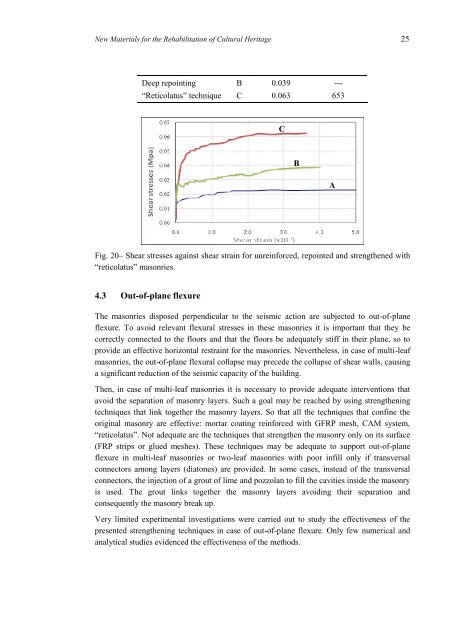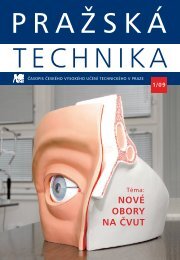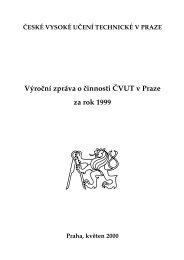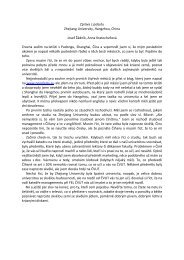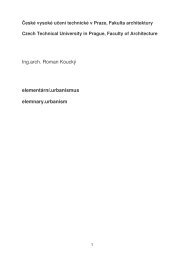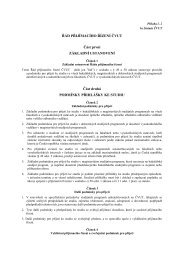New Materials for the Rehabilitation of Cultural Heritage - Czech ...
New Materials for the Rehabilitation of Cultural Heritage - Czech ...
New Materials for the Rehabilitation of Cultural Heritage - Czech ...
You also want an ePaper? Increase the reach of your titles
YUMPU automatically turns print PDFs into web optimized ePapers that Google loves.
<strong>New</strong> <strong>Materials</strong> <strong>for</strong> <strong>the</strong> <strong>Rehabilitation</strong> <strong>of</strong> <strong>Cultural</strong> <strong>Heritage</strong> 25<br />
Deep repointing B 0.039 ---<br />
“Reticolatus” technique C 0.063 653<br />
Fig. 20–Shear stresses against shear strain <strong>for</strong> unrein<strong>for</strong>ced, repointed and streng<strong>the</strong>ned with<br />
“reticolatus” masonries.<br />
4.3 Out-<strong>of</strong>-plane flexure<br />
The masonries disposed perpendicular to <strong>the</strong> seismic action are subjected to out-<strong>of</strong>-plane<br />
flexure. To avoid relevant flexural stresses in <strong>the</strong>se masonries it is important that <strong>the</strong>y be<br />
correctly connected to <strong>the</strong> floors and that <strong>the</strong> floors be adequately stiff in <strong>the</strong>ir plane, so to<br />
provide an effective horizontal restraint <strong>for</strong> <strong>the</strong> masonries. Never<strong>the</strong>less, in case <strong>of</strong> multi-leaf<br />
masonries, <strong>the</strong> out-<strong>of</strong>-plane flexural collapse may precede <strong>the</strong> collapse <strong>of</strong> shear walls, causing<br />
a significant reduction <strong>of</strong> <strong>the</strong> seismic capacity <strong>of</strong> <strong>the</strong> building.<br />
Then, in case <strong>of</strong> multi-leaf masonries it is necessary to provide adequate interventions that<br />
avoid <strong>the</strong> separation <strong>of</strong> masonry layers. Such a goal may be reached by using streng<strong>the</strong>ning<br />
techniques that link toge<strong>the</strong>r <strong>the</strong> masonry layers. So that all <strong>the</strong> techniques that confine <strong>the</strong><br />
original masonry are effective: mortar coating rein<strong>for</strong>ced with GFRP mesh, CAM system,<br />
“reticolatus”. Not adequate are <strong>the</strong> techniques that streng<strong>the</strong>n <strong>the</strong> masonry only on its surface<br />
(FRP strips or glued meshes). These techniques may be adequate to support out-<strong>of</strong>-plane<br />
flexure in multi-leaf masonries or two-leaf masonries with poor infill only if transversal<br />
connectors among layers (diatones) are provided. In some cases, instead <strong>of</strong> <strong>the</strong> transversal<br />
connectors, <strong>the</strong> injection <strong>of</strong> a grout <strong>of</strong> lime and pozzolan to fill <strong>the</strong> cavities inside <strong>the</strong> masonry<br />
is used. The grout links toge<strong>the</strong>r <strong>the</strong> masonry layers avoiding <strong>the</strong>ir separation and<br />
consequently <strong>the</strong> masonry break up.<br />
Very limited experimental investigations were carried out to study <strong>the</strong> effectiveness <strong>of</strong> <strong>the</strong><br />
presented streng<strong>the</strong>ning techniques in case <strong>of</strong> out-<strong>of</strong>-plane flexure. Only few numerical and<br />
analytical studies evidenced <strong>the</strong> effectiveness <strong>of</strong> <strong>the</strong> methods.<br />
C<br />
B<br />
A


